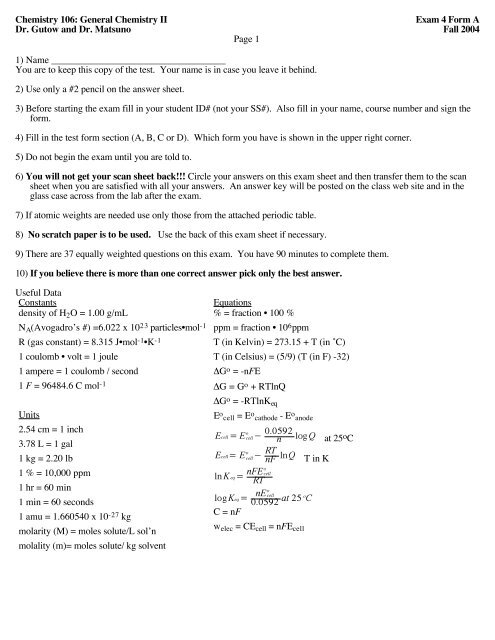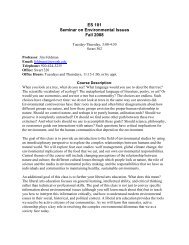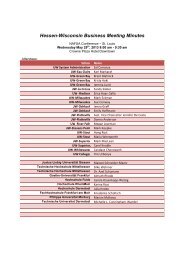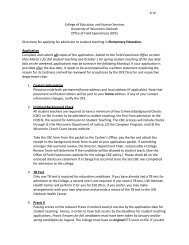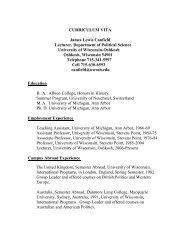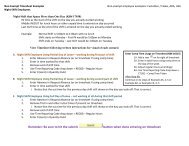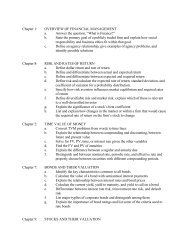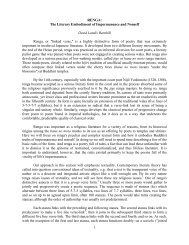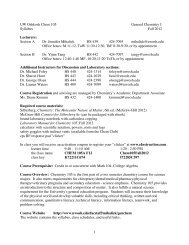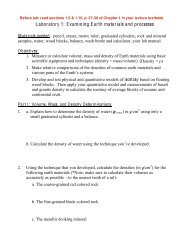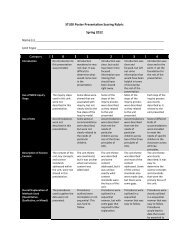You also want an ePaper? Increase the reach of your titles
YUMPU automatically turns print PDFs into web optimized ePapers that Google loves.
Chemistry 106: General Chemistry II<br />
<strong>Exam</strong> 4 Form A<br />
Dr. Gutow and Dr. Matsuno Fall 2004<br />
Page 1<br />
1) Name ____________________________________<br />
You are to keep this copy of the test. Your name is in case you leave it behind.<br />
2) Use only a #2 pencil on the answer sheet.<br />
3) Before starting the exam fill in your student ID# (not your SS#). Also fill in your name, course number and sign the<br />
form.<br />
4) Fill in the test form section (A, B, C or D). Which form you have is shown in the upper right corner.<br />
5) Do not begin the exam until you are told to.<br />
6) You will not get your scan sheet back!!! Circle your answers on this exam sheet and then transfer them to the scan<br />
sheet when you are satisfied with all your answers. An answer key will be posted on the class web site and in the<br />
glass case across from the lab after the exam.<br />
7) If atomic weights are needed use only those from the attached periodic table.<br />
8) No scratch paper is to be used. Use the back of this exam sheet if necessary.<br />
9) There are 37 equally weighted questions on this exam. You have 90 minutes to complete them.<br />
10) If you believe there is more than one correct answer pick only the best answer.<br />
Useful Data<br />
Constants<br />
density of H 2 O = 1.00 g/mL<br />
N A (Avogadro’s #) =6.022 x 10 23 particles•mol -1<br />
R (gas constant) = 8.315 J•mol -1 •K -1<br />
1 coulomb • volt = 1 joule<br />
1 ampere = 1 coulomb / second<br />
1 F = 96484.6 C mol -1<br />
Units<br />
2.54 cm = 1 inch<br />
3.78 L = 1 gal<br />
1 kg = 2.20 lb<br />
1 % = 10,000 ppm<br />
1 hr = 60 min<br />
1 min = 60 seconds<br />
1 amu = 1.660540 x 10 -27 kg<br />
molarity (M) = moles solute/L sol’n<br />
molality (m)= moles solute/ kg solvent<br />
Equations<br />
% = fraction • 100 %<br />
ppm = fraction • 10 6 ppm<br />
T (in Kelvin) = 273.15 + T (in ˚C)<br />
T (in Celsius) = (5/9) (T (in F) -32)<br />
ΔG o = -nFE<br />
∆G = G o + RTlnQ<br />
∆G o = -RTlnK eq<br />
Ε o cell = E o cathode - E o anode<br />
o 0.0592<br />
Ecell = E cell - n log Q at 25 o C<br />
o RT<br />
Ecell= E cell - nF ln Q<br />
o<br />
nFE<br />
ln K eq =<br />
cell<br />
RT<br />
o<br />
nE<br />
logKeq =<br />
cell<br />
0.0592<br />
C = nF<br />
at 25 o C<br />
w elec = CE cell = nFE cell<br />
T in K
Chemistry 106: General Chemistry II<br />
<strong>Exam</strong> 4 Form A<br />
Dr. Gutow and Dr. Matsuno Fall 2004<br />
Page 2<br />
1. What is the oxidation state of Chromium in Na 2 Cr 2 O 7 ?<br />
a. +2<br />
b. +3<br />
c. +4<br />
d. +6<br />
e. 0<br />
2. In a voltaic cell, electrons flow from the<br />
a. anode to the cathode.<br />
b. cathode to the anode.<br />
c. anode to the salt bridge.<br />
d. cathode to the salt bridge.<br />
e. the metal surface to the electrolytes<br />
3. The following reaction occurs when zinc is placed in contact with a solution of lead(II) ions:<br />
Zn(s) + Pb 2+ (aq) → Zn 2+ (aq) + Pb(s)<br />
Which one correctly shows one of the half-reactions for the chemical equation above?<br />
a. Pb (s) → Pb 2+ (aq) + 2e -<br />
b. Pb (s) + 2e - → Pb 2+ (aq)<br />
c. Pb 2+ (aq) → Pb (aq) + 2e -<br />
d. Pb 2+ (aq) + 2e - → Pb (s)<br />
e. Pb (s) → Pb 2+ (aq)<br />
4. If the value of E cell is 1.20 V, what is the free energy change associated with the oxidation reduction reaction<br />
involved? Assume that one electron is transferred in this process.<br />
a. 1.16 x 10 5 J/mol<br />
b. 1.20 J/mol<br />
c. -1.20 J/mol<br />
d. -1.16 x 10 5 J/mol<br />
e. 1.20 x 10 5 J/mol<br />
5. _O 2 (g) + _H + (aq) + _Fe(s) → _H 2 O(l) + _Fe 2+ (aq)<br />
What is the correct stoichiometry of the equation above?<br />
a. 1,4,2,2,2<br />
b. 2,3,1,1,8<br />
c. 1,14,2,1<br />
d. 1,2,4,2,2<br />
e. 1,4,1,2,1
Chemistry 106: General Chemistry II<br />
<strong>Exam</strong> 4 Form A<br />
Dr. Gutow and Dr. Matsuno Fall 2004<br />
Page 3<br />
6. In attempting to balance a redox reaction, a student came up with the following half reactions:<br />
Cr 2 O 7<br />
2- + 14H + + 6e- → 2Cr 3+ + 7H 2 O<br />
SO 4<br />
2- + 4H + + 2e - → H 2 SO 3 + H 2 O<br />
There seems to be a problem in adding these two reactions together. What advice or hint would you give to this<br />
student?<br />
a. Multiply all balancing coefficients in the second reaction by 4.<br />
b. Just add the reactants to reactants and products to products.<br />
c. The individual half reactions are not balanced correctly.<br />
d. These are both reduction reactions.<br />
e. There must be a salt bridge in these equation.<br />
7. Using the following data, determine the value of E o cell for the electrochemical cell constructed using the following<br />
reaction, where zinc is the anode and lead is the cathode:<br />
Zn(s) + Pb 2+ (aq) –––> Zn 2+ (aq) + Pb(s)<br />
Half Reaction<br />
Zn 2+ (aq) + 2e - → Zn(s)<br />
Pb 2+ (aq) + 2e - → Pb(s)<br />
E o red (V vs. SHE)<br />
-0.763 V<br />
-0.126 V<br />
a. 0.637 V<br />
b. -0.637 V<br />
c. 1.274 V<br />
d. -1.274 V<br />
e. 0.763
Chemistry 106: General Chemistry II<br />
<strong>Exam</strong> 4 Form A<br />
Dr. Gutow and Dr. Matsuno Fall 2004<br />
Page 4<br />
8. Consider the following diagram<br />
Half Reaction<br />
Cu 2+ (aq) + 2e - → Cu(s)<br />
Cd 2+ (aq) + 2e - → Cd(s)<br />
E o red (V vs. SHE)<br />
0.3419 V<br />
-0.403 V<br />
The direction of the electron flow is____________.<br />
a. from anode to cathode through voltometer, so it flows from Cu electrode to Cd electrode.<br />
b. from cathode to anode through voltmeter, so it flows from Cd electrode to Cu electrode<br />
c. from anode to cathode through voltometer, so it flows from Cd electrode to Cu electrode<br />
d. from cathode to anode through voltometer, so it flows from Cu electrode to Cd electrode<br />
e. fom cathode to anode, through voltomer so it flows from Cu +2 to Cu electrode<br />
9. An electrochemical cell is constructed with a zinc metal anode in contact with a 0.052 M solution of zinc(II) nitrate<br />
and a silver cathode in contact with a 0.0042 M solution of silver(I) nitrate. What is the EMF of this cell at 5ºC?<br />
Metal/metal ion<br />
Eº red (V vs SHE)<br />
silver/silver(I) 0.799<br />
zinc/zinc(II) -0.762<br />
Useful Information: 2Ag + (aq) + Zn(s) --> Zn 2+ (aq) + 2Ag(s)<br />
a. 1.657 V<br />
b. 1.465 V<br />
c. 1.561 V<br />
d. 1.502 V<br />
e. 1.145 V<br />
Generating EPSF... Sheet #1 Layer #1 X: 5.53in Y: 3.80in<br />
99 050 %<br />
%
Chemistry 106: General Chemistry II<br />
<strong>Exam</strong> 4 Form A<br />
Dr. Gutow and Dr. Matsuno Fall 2004<br />
Page 5<br />
10. An electrochemical cell is constructed based on the oxidation of zinc by silver nitrate to make silver and zinc nitrate.<br />
Locate the silver nitrate on the diagram.<br />
11. Calculate the equilibrium constant K eq of the reaction,<br />
O 2 (g) +4H + (aq) + 4Fe 2+ (aq) --> 4Fe 3+ (aq) +2H 2 O, using the following information and the Nernst equation.<br />
Reductioin: O 2 (g) +4H + (aq) + 4e - --> 2H 2 O E o red = +1.23 V<br />
Oxidation: 4Fe 2+ (aq) --> 4Fe 3+ (aq) + 4e - E o red = +0.77 V<br />
a. 31<br />
b. 0.46<br />
c. 1.84<br />
d. 0.0032<br />
e. 1 x 10 31<br />
12. A spontaneous redox reaction has<br />
a. a negative value of E cell and a negative value of ΔG.<br />
b. a positive value of E cell and a positive value of ΔG.<br />
c. a negative value of E cell and a positive value of ΔG.<br />
d. a positive value of E cell and a negative value of ΔG.<br />
e. a value of E cell based on 25 o C<br />
13. Does pH have an effect on the E cell value of the following oxidation-reduction reaction?<br />
5 Fe 2+ (aq) + MnO 4 - (aq) + 8H + (aq) →<br />
5 Fe 3+ (aq) + Mn 2+ (aq) + 4 H 2 O(l)<br />
a. Yes. E cell values for all redox reactions have a dependence on pH.<br />
b. Yes. E cell values for redox reactions involving the proton have a dependence on pH.<br />
c. No. E cell values for redox reactions depend only on the major species in the reaction-in this case, Fe 2+ , MnO 4- ,<br />
Fe 3+ and Mn 2+ .<br />
d. No. E cell values for redox reactions depend on concentrations and temperatures, but not on pH.<br />
e. No. E cell values for the redox reaction depends on the equilibrium constant, K eq<br />
14. How long would it take to electroplate a flute with 28.3 grams of silver at a constant current of 2.0 amps using<br />
AgNO 3 ?<br />
a. 211 minutes<br />
b. 422 minutes<br />
c. 844 minutes<br />
d. 1688 minutes<br />
e.56.6 minutes
Chemistry 106: General Chemistry II<br />
<strong>Exam</strong> 4 Form A<br />
Dr. Gutow and Dr. Matsuno Fall 2004<br />
Page 6<br />
15. A NiMH battery uses the following electrochemical reaction:<br />
NiO(OH)(s) + MH(s) → Ni(OH) 2 (s) + M(s) in KOH (aq)<br />
E o cell =1.32 V<br />
When recharging this battery, one of the possible half reactions is 2H + (aq) + 2e - → Η 2 (g),. This reaction is<br />
unlikely to happen. Why?<br />
a. because of the overpotenial, the gas forming at the electrode needs higher than normal E o red.<br />
b. because Nickel must be oxided to +4.<br />
c. because the solution is basic<br />
d. a and c<br />
e. a, b and c<br />
16. In the electrolysis of H 2 O that contains NaI (aq), which reaction(s) below will happen when 9.0V are applied?<br />
E o red (V)<br />
1. 4H 2 O (l) + 4e - → 2H 2 (g) + 4OH - (aq) -0.8277<br />
2. Na + (aq) + e - → Na(s) -2.714<br />
3. 2H 2 O(l) → Ο 2 (g) + 4H + (aq) + 4e - 1.229<br />
4. 2I - (aq) → I 2 (s) + 2e - 0.535<br />
a. 1<br />
b. 2<br />
c. 1 and 2<br />
d. 1 and 4<br />
e. 1, 3, and 4<br />
17. What is an advantage of fuel cells compared to combustion-based energy sources?<br />
a. The efficiency is higher.<br />
b. It utilizes the “clean”energy source such as fusion.<br />
c. Hydrogen is readily available from a metal hydride ore.<br />
d. a and b<br />
e. a, b and c<br />
18. How much energy can a Zn/Cu voltaic cell produce if you have 65.0 g of Zn? Assume only the following reaction<br />
is taking place.<br />
Zn(s) + Cu 2+ (aq) → Zn 2+ (aq) + Cu(s) E o cell = 1.1V<br />
a. 1.1 x 10 5 J<br />
b. 2.1 x 10 5 J<br />
c. 9.59 x 10 4 J<br />
d. 1.91 x 10 5 J<br />
e. 2.2 J
Chemistry 106: General Chemistry II<br />
<strong>Exam</strong> 4 Form A<br />
Dr. Gutow and Dr. Matsuno Fall 2004<br />
Page 7<br />
19. The figure below depicts a possible anti-rust coating(Zinc, Zn) on the Iron (Fe) metal. Does the anti-rust coating<br />
really work? Choose the answer and statement that best describes the reason.<br />
Zn 2+ (aq) + 2e - → Zn(s)<br />
Fe 2+ (aq) + 2e - → Fe(s)<br />
E o red (V)<br />
-0.763 V<br />
-0.440 V<br />
a. No. Becuase Zn has a lower reduction potential, so it actually helps Fe to rust faster.<br />
b. No. Because Zn has a higher reduction potential, but it doesn’t make any difference.<br />
c. Yes. Becuase Zn has a higher reduction potential, so it actually works.<br />
d. Yes. Because Zn has a lower reduction potential than Fe, so it oxidizes before Fe.<br />
e. Both metals will rust at a same time with a presence of water.<br />
20. What disadvantages are there to the use of hydrogen fuel cells instead of gasoline in vehicles?<br />
a.difficulty of storage of hydrogen<br />
b. no distribution network of hydrogen fuel in place<br />
c. Hydrogen fuel must be produced at the expense of another energy source.<br />
d. a and b<br />
e. a, b and c<br />
21. A typical Lead-Acid automotive battery produces about 12 Volts. The E o cell for Pb/H 2 SO 4 battery is 2.0 V. How<br />
do automotive batteries achieve the 12Volts output?<br />
a. By stacking many cells within the battery case.<br />
b. By using 6 times the concentration of the electrolytes.<br />
c. By increasing the temperature of the cell while the car is driven.<br />
d. a and b<br />
e. a, b and c<br />
22. Copper(II) oxide was reduced to copper metal at high temperatures in ancient refining processes by<br />
a. CO(g)<br />
b. CO 2 (g)<br />
c. O 2 (g)<br />
d. C (g)<br />
e. N 2 (g)
Chemistry 106: General Chemistry II<br />
<strong>Exam</strong> 4 Form A<br />
Dr. Gutow and Dr. Matsuno Fall 2004<br />
Page 8<br />
23. Copper samples have varying degrees of hardness that depend upon<br />
a. the dimensions of its unit cell<br />
b. the predominant isotope in the sample<br />
c. the density of the atoms in the unit cell<br />
d. the number of intersecting line defects in the lattice<br />
e. which type of unit cell the lattice is made from<br />
24. Iron oxide is smelted to form metallic iron according to the following chemical reaction:<br />
Fe 2 O 3 (s) + 3CO(g) ––––> 2Fe(l) + 3CO 2 (g).<br />
What is the change in oxidation number of iron during this process?<br />
a. +2 b. +3 c. -2 d. -3 e. +1<br />
25. The higher the carbon content in steel<br />
a. the stronger and more malleable it is.<br />
b. the stronger and more brittle it is.<br />
c. the weaker and more malleable it is.<br />
d. the weaker and more brittle it is.<br />
e. the weaker and more ductile it is.<br />
26. Stainless steel is less susceptible to rusting than iron because<br />
a. it is coated with plastic.<br />
b. the carbon within the alloy polymerizes to form a protective film.<br />
c. the silicon within the alloy oxidizes to form a protective silicate layer.<br />
d. any iron that oxidizes is rapidly reduced by the other metals in the alloy.<br />
e. other metals than iron in the alloy are oxidized more easily than iron forming protective oxides.<br />
27. Which physical property below is NOT characteristic of metals?<br />
a. they are shiny (high luster)<br />
b. they are good electrical conductors.<br />
c. they are thermal insulators.<br />
d. they are malleable.<br />
e. they are ductile.<br />
28. Aluminum is prepared by<br />
a. smelting with CO at very high temperatures<br />
b. driving off oxygen from the oxide Al 2 O 3 at 2240 ˚C.<br />
c. reaction with perchloric acid, which neutralizes the oxide ion in Al 2 O 3 .<br />
d. electrolysis of Al 2 O 3 dissolved in molten cryolite<br />
e. reaction of Al(CN) 3 with Zn to reduce the Al 3+ to Al.<br />
29. One common iron containing mineral is known as “fool’s gold” or iron pyrite. The chemical formula for this<br />
mineral is FeS 2 . What is the % by mass of iron in fool’s gold? Iron pyrite is not usually used as a source of iron,<br />
but it could be.<br />
a. 46.547%<br />
b. 0.466%<br />
c. 2.1484%<br />
d. 87.081%<br />
e. 26.726%
Chemistry 106: General Chemistry II<br />
<strong>Exam</strong> 4 Form A<br />
Dr. Gutow and Dr. Matsuno Fall 2004<br />
Page 9<br />
30. A ceramic is<br />
a. a chemically resistant and heat-resistant solid produced by heating compounds containing cerium.<br />
b. a chemically resistant and heat-resistant solid produced by heating clays.<br />
c. a chemically resistant and heat-resistant solid produced by heating sand and water.<br />
d. a chemically resistant and heat-resistant solid produced by heating any compounds containing aluminum and<br />
sulfur.<br />
e. a chemically resistant and heat-resistant solid produced by heating clays in a reducing atmosphere.<br />
31. The band gap<br />
a. in metals is large, in semiconductors is small and in insulators is zero.<br />
b. in metals is small, in semiconductors is large and in insulators is zero.<br />
c. in metals is zero, in semiconductors is large and in insulators is small.<br />
d. in metals is small, in semiconductors is zero and in insulators is large.<br />
e. in metals is zero, in semiconductors is small and in insulators is large.<br />
32. A silicon sample is doped with P. It is a<br />
a. p-type semiconductor with an excess of electrons.<br />
b. n-type semiconductor with a deficiency of electrons.<br />
c. p-type semiconductor with a deficiency of electrons.<br />
d. n-type semiconductor with an excess of electrons.<br />
e. n-p-type semiconductor which will generate electricity when exposed to light.<br />
33. Doping is used in photovoltaic cells to<br />
a. control the color of light that is absorbed.<br />
b. provide an emf to push electrons through the circuit and shrink the band gap to increase the absorption of<br />
longer wavelength light.<br />
c. provide a use for silicon that is too impure for use in electronics.<br />
d. increase the band gap to reduce the absorption of longer wavelength light and provide an emf to push<br />
electrons through the circuit.<br />
e. provide the electrons necessary for current to flow in the external circuit.
Chemistry 106: General Chemistry II<br />
<strong>Exam</strong> 4 Form A<br />
Dr. Gutow and Dr. Matsuno Fall 2004<br />
Page 10<br />
34. The most commonly recycled plastics are<br />
O O<br />
–CH 2<br />
–CH 2<br />
–O–C– –C–O–<br />
n<br />
Polyethylene terephthalate (PET)<br />
–CH 2<br />
–CH 2<br />
–<br />
n<br />
Low and high density polyethylene (LDPE,HDPE)<br />
–CH–CH 2<br />
–<br />
n<br />
–CH–CH 2<br />
–<br />
n<br />
CH 3<br />
Polypropylene (PP)<br />
–CH–CH 2<br />
–<br />
n<br />
Cl<br />
Polyvinyl chloride (PVC)<br />
Which of the above polymers is NOT an addition polymer?<br />
a. PET<br />
b. LDPE/HDPE<br />
c. PP<br />
d. PS<br />
e. PVC<br />
35. Polymers that have significant inter-chain hydrogen-bonding interactions<br />
a. repel water and form weak fibers.<br />
b. repel water and form strong fibers.<br />
c. absorb water and form weak fibers.<br />
d. absorb water and form strong fibers.<br />
e. none of the above.<br />
Polystyrene (PS)
Chemistry 106: General Chemistry II<br />
<strong>Exam</strong> 4 Form A<br />
Dr. Gutow and Dr. Matsuno Fall 2004<br />
Page 11<br />
36. Consider the common synthetic polymers below.<br />
O O<br />
–CH 2<br />
–CH 2<br />
–O–C– –C–O–<br />
n<br />
Polyethylene terephthalate (PET)<br />
–CH 2<br />
–CH 2<br />
–<br />
n<br />
Low and high density polyethylene (LDPE,HDPE)<br />
–CH–CH 2<br />
–<br />
n<br />
–CH–CH 2<br />
–<br />
n<br />
CH 3<br />
Polypropylene (PP)<br />
–CH–CH 2<br />
–<br />
n<br />
Cl<br />
Polyvinyl chloride (PVC)<br />
Which ones will form the least elastic fibers?<br />
a. PET and PP<br />
b. PET and PS<br />
c. LDPE, HDPE and PP<br />
d. PP and PVC<br />
e. PS and PP<br />
37. Large crystalline domains in polymers lead to<br />
a. weaker stiff polymers.<br />
b. more elastic soft polymers.<br />
c. stronger stiff polymers.<br />
d. weaker soft polymers.<br />
e. more elastic stiff polymers.<br />
Polystyrene (PS)


